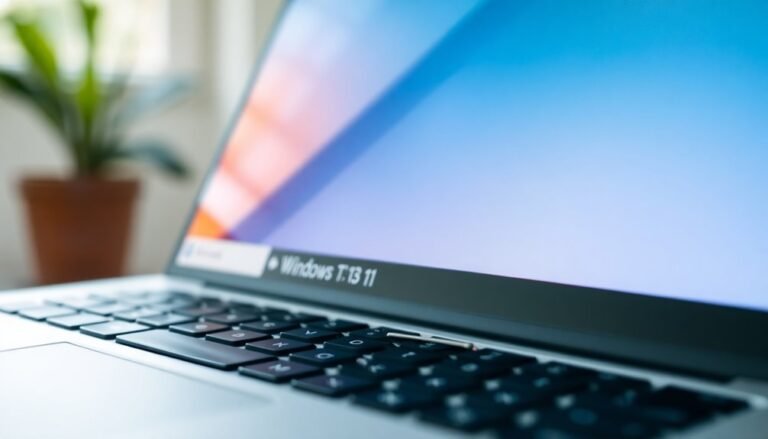Virtual Memory Usage High: Fix Virtual Memory Problems

If you’re experiencing high virtual memory usage, begin by pinpointing the causes, such as background processes and resource-intensive applications. Common symptoms include sluggish performance and frequent application freezes.
To resolve these issues, consider adjusting your paging file size and optimizing its location on SSDs. Regular monitoring with tools like Task Manager can assist in tracking usage trends effectively.
By implementing these strategies, you can enhance your system’s performance. Explore additional techniques to ensure optimal virtual memory management.
Causes of High Virtual Memory Usage

High virtual memory usage can significantly impact your system’s performance, and understanding its causes is crucial for maintaining optimal functionality.
One of the most common reasons for excessive virtual memory consumption is the presence of numerous background processes. Running multiple applications simultaneously, along with unnecessary startup programs, can quickly deplete your virtual memory reserves. Additionally, resource-intensive software like video games or graphic design tools can exacerbate this issue. To mitigate this, consider managing excessive simultaneous applications to streamline memory usage.
Memory leaks in poorly optimized applications are another contributing factor, as they can increase virtual memory demands over time. Outdated drivers may also lead to these leaks, compromising your system’s efficiency.
Furthermore, insufficient physical RAM can cause your system to rely heavily on virtual memory, particularly under heavy workloads. This reliance can result in a dramatic increase in virtual memory usage.
Lastly, improper virtual memory configuration, such as mismanaged paging file sizes or static settings, can hinder performance.
To effectively reduce high virtual memory usage, it’s essential to identify and address these key causes. By doing so, you can enhance your system’s responsiveness and overall stability, ensuring a smoother computing experience.
Symptoms Indicating Virtual Memory Problems
Identifying symptoms of virtual memory problems is crucial for tackling underlying issues that may impact your computer’s performance. Users often experience a variety of cognitive, behavioral, and functional indicators of these memory-related problems.
Here are the key symptoms to watch for:
- Frequent forgetfulness disrupting daily routines.
- Difficulty remembering recent conversations or details.
- Struggles with completing familiar tasks, like following recipes.
- Increased confusion in familiar environments or activities.
- Reduced ability to multitask or maintain concentration.
These symptoms may signal impaired memory functionality, leading to frustrating experiences and potential anxiety. Additionally, difficulty handling simple tasks can further exacerbate feelings of confusion, making it essential to address these issues promptly.
Changes in personality, such as increased irritability or lethargy, could also indicate issues with virtual memory. By recognizing these signs early, you can take proactive measures for diagnosis and remediation, ultimately improving your system’s performance and enhancing mental clarity.
Stay informed to ensure optimal functionality and a smoother computing experience.
Diagnosing Virtual Memory Issues
Diagnosing virtual memory issues on your system is essential for maintaining optimal performance. To start, use the Virtual Memory Validator (VM Validator), an essential tool that provides real-time insights into both your application’s virtual and physical memory usage.
With VM Validator, you can access detailed layouts, which include private memory allocations and DLL usage, allowing you to filter and focus on specific memory types, including those in the working set.
Additionally, it’s crucial to run memory testing utilities such as the Windows Memory Diagnostic Tool or MemTest86. These utilities check the stability of your RAM and can help identify any faulty modules that might be impacting your virtual memory performance. Keeping your RAM in top condition is vital for smooth system operation.
Finally, monitor memory consumption using Task Manager and other OS-level utilities. Look closely at applications that consume excessive virtual memory and keep track of system events and page fault logs.
This comprehensive approach enables you to uncover potential bottlenecks and inefficient memory allocations, paving the way for effective troubleshooting and enhanced system performance. By following these steps, you’ll be well-equipped to handle any virtual memory challenges that arise on your system.
Fixes and Optimization Techniques
Boost Your System Performance with Virtual Memory Optimization Techniques****
Are you struggling with virtual memory issues? Implementing effective fixes and optimization techniques can significantly enhance your system’s performance. Here are some essential strategies to consider for improving virtual memory management:
- Set Consistent Paging File Sizes: Configure both the initial and maximum paging file sizes to the same value. This prevents the operating system from constantly resizing, which can lead to performance lags.
- Increase Paging File Size for Heavy Usage: If your system experiences heavy workloads, increasing the paging file size can help reduce page faults and improve responsiveness during taxing operations.
- Optimize Drive Placement: Place your paging file on the fastest drive available, such as a solid-state drive (SSD). This ensures quicker access to virtual memory, which enhances overall system speed.
- Regular Maintenance: Regularly clear or defragment the location of your paging file to improve efficiency. This routine maintenance can help keep your system running smoothly.
- Avoid Disabling the Paging File: Even if your system boasts high RAM, never disable the paging file. Maintaining it ensures stability during peak workloads, preventing unexpected crashes.
Additionally, consider optimizing your memory allocation strategies and leveraging hardware-assisted virtualization for even greater improvements.
Regular monitoring of your memory usage allows you to dynamically adapt these enhancements, ensuring your system operates at peak efficiency. By employing these techniques, you can effectively manage your virtual memory and significantly boost your overall system performance.
Stay ahead of your technology needs and ensure a smooth experience by following these vital virtual memory optimization strategies!
Impact of Virtual Memory Problems on Performance

Virtual memory issues can significantly degrade your system’s performance, leading to resource contention and increased overhead. When your system’s RAM is limited, high reliance on virtual memory can cause frequent page faults and excessive swapping. This situation can overwhelm disk I/O bandwidth, resulting in slower data access and consuming critical CPU cycles for managing page tables and memory addressing.
Consequently, users may encounter thrashing, where system performance plummets, and application responsiveness declines due to ongoing memory management demands.
Moreover, the complex nature of virtual memory introduces additional computational overhead, placing a burden on the CPU with tasks like memory management and address translation. While virtual memory facilitates multitasking by isolating processes, an overreliance on it can lead to reduced system performance and even application freezes.
To ensure optimized efficiency and stability in your computer system, it’s essential to address these virtual memory challenges. This way, you can guarantee a smoother and more responsive experience across all applications.
Specific Considerations for Virtual Machines
As organizations increasingly turn to virtual machines for enhanced flexibility and scalability, it’s essential to address specific considerations that can optimize performance and resource management.
Here are several critical aspects to keep in mind for effective virtual machine management:
- Memory Ballooning: Implement balloon drivers to reclaim unused memory. However, it’s important to monitor the system closely to prevent any potential performance degradation.
- Dynamic Memory Allocation: Take advantage of Hyper-V’s features that allow real-time memory adjustments. Ensure you establish clear minimum and maximum limits for optimal resource utilization.
- Caution with Memory Overcommitment: Be mindful when allocating more memory than what’s physically available. Overcommitting memory can result in VM swapping, which can significantly impact performance.
- Memory Mirroring for Fault Tolerance: Employ memory mirroring in critical virtual machines to enhance fault tolerance. Keep in mind the balance between reliability and reduced capacity.
- Regular Hypervisor Updates: Ensure your hypervisor is regularly updated and properly configured. Adjust memory buffer settings to align with your specific workload requirements for optimal performance.
How to Monitor Memory Usage Effectively
How can you effectively monitor memory usage to ensure optimal system performance? Start by utilizing powerful tools like `sar` on Linux, which provides detailed historical memory reports that help you identify trends and troubleshoot issues.
To visualize critical metrics such as RSS (Resident Set Size) and VSZ (Virtual Size), consider using graphing solutions like `gnuplot`. For real-time monitoring, Remote Desktop Protocols (RDP) serve as a straightforward method to keep an eye on CPU and memory usage on your system.
Additionally, robust monitoring platforms like Nagios and Zabbix can facilitate scalable memory tracking across various environments, enhancing your overall systems management. Integrating SNMP (Simple Network Management Protocol) agents on your network devices allows for centralized monitoring, greatly improving your oversight capabilities.
It’s crucial to establish threshold values for alerts, enabling you to detect potential issues proactively before they escalate. By continuously evaluating memory usage trends, you’ll be better positioned to identify memory leaks early on.
Utilize dashboards that combine current memory usage with historical data for comprehensive insights into your system’s health. Automating alerting and data collection processes not only expedites your response to incidents but also ensures that you maintain excellent system performance.
Upgrading Your System for Better Performance
Upgrade Your System for Optimal Performance: A Comprehensive Guide
If you’re looking to boost your system’s performance, strategic upgrades can make a significant difference, particularly in how your computer manages memory. Here are some effective ways to enhance your system’s capabilities:
- Increase Your RAM: Adding more RAM reduces your system’s dependence on virtual memory. This results in faster processing times and enables you to run multiple applications simultaneously without excessive paging interruptions.
- Switch to an SSD: Upgrading from a traditional HDD to a Solid State Drive (SSD) dramatically improves read and write speeds. This transition not only accelerates your system’s boot time but also makes virtual memory operations much quicker and more efficient.
- Optimize Page File Settings: Manually configuring your page file size can lead to optimized performance, particularly when utilizing RAM-intensive applications. Tailoring these settings according to your specific needs can provide a smoother user experience.
- Perform Regular System Maintenance: Implementing routine disk defragmentation and clearing temporary files can enhance access speeds and increase the overall available virtual memory. Regular maintenance keeps your system running efficiently.
- Keep Your System Updated: Ensuring that your operating system and drivers are up to date allows your hardware to function optimally in conjunction with the latest software enhancements and advancements.
By investing in these upgrades, you’ll not only improve your system’s responsiveness but also reduce the likelihood of memory-related issues that can slow down performance.
Explore these options today to maximize your computer’s potential!
Reducing Memory Footprint of Applications

Reducing the memory footprint of applications is critical for optimizing performance, particularly in resource-constrained environments. To effectively lower memory usage, start by implementing efficient data loading strategies, such as reading datasets in smaller chunks and utilizing lazy loading techniques through generators. These methods can significantly decrease memory consumption.
Additionally, consider streaming data processing to avoid memory spikes that often occur during bulk loading.
When dealing with large datasets, prioritize using iterators or generators instead of traditional data structures, as they help conserve RAM. In your coding practices, aim to minimize dynamic memory allocation, which can enhance performance predictability and reduce memory fragmentation.
For embedded systems, leveraging memory pooling is a great way to optimize memory reuse and manage resources effectively under tight constraints.
It’s also important to reflect on the programming language you choose. Certain languages, like Kotlin Native, can provide lower memory overhead compared to those based on the JVM.
Consistently monitoring and profiling your memory usage is crucial to identify and address inefficiencies. Additionally, always remember to close unnecessary applications to free up valuable RAM.
Best Practices for Virtual Memory Management
When it comes to optimizing virtual memory management, implementing effective strategies can significantly improve system performance and responsiveness.
Here are some essential best practices to enhance your virtual memory management:
- Adjust the Page File Size: Customizing the size of your page file can help strike a balance between performance and disk space efficiency.
- Place the Page File on an SSD: Storing your page file on a Solid State Drive (SSD) can dramatically boost read and write speeds, reducing performance bottlenecks.
- Monitor Virtual Memory Usage: Take advantage of built-in monitoring tools to keep an eye on your virtual memory consumption. Identifying issues early on can prevent them from escalating.
- Optimize Algorithms and Settings: Fine-tuning parameters such as swap frequency can enhance overall efficiency and minimize page faults, improving system responsiveness.
- Regularly Review and Document Configurations: Make it a habit to document any changes made to page file settings and their corresponding effects. This practice aids in maintaining optimal performance in the long run.
Frequently Asked Questions
Can Virtual Memory Be Disabled Completely on My System?
Yes, you can completely disable virtual memory on your system. However, be cautious; doing so may lead to instability or crashes if your physical RAM becomes exhausted. Make certain you monitor performance closely after making changes.
How Does Virtual Memory Affect Gaming Performance Specifically?
Think of virtual memory as a crowded highway during rush hour; it slows down traffic. In gaming, it causes lag and lowers frame rates when overwhelmed, making sufficient RAM essential for smooth, responsive performance.
Are There Tools to Visualize Memory Usage Trends Over Time?
Yes, tools like Visual Studio’s Memory Usage tool and AMD Radeon™ Memory Visualizer allow you to visualize memory usage trends over time, tracking changes in allocations and spotting potential leaks or performance bottlenecks effectively.
What Are the Risks of Manually Adjusting Paging File Settings?
Manually adjusting paging file settings can lead to system instability, boot failures, insufficient virtual memory, incomplete crash dumps, and degraded performance. Misconfiguration often results from misunderstanding requirements, risking effective resource management and operational reliability.
Does Upgrading to an SSD Improve Virtual Memory Performance?
Upgrading to an SSD is like putting jet fuel in your system’s engine; it greatly enhances virtual memory performance by speeding up read/write times, reducing paging delays, and increasing overall responsiveness during memory-intensive tasks.
Conclusion
In a world where high virtual memory usage can feel like a digital apocalypse, taking control of your system is essential. Don’t let sluggish performance drag you down into the depths of despair! By diagnosing issues and applying effective fixes, you can transform your computing experience from frustrating to fantastically fast. Monitor your memory usage like a hawk, optimize your applications, and embrace best practices. Your system’s performance revival is just a few tweaks away—seize the chance to reignite your productivity!





